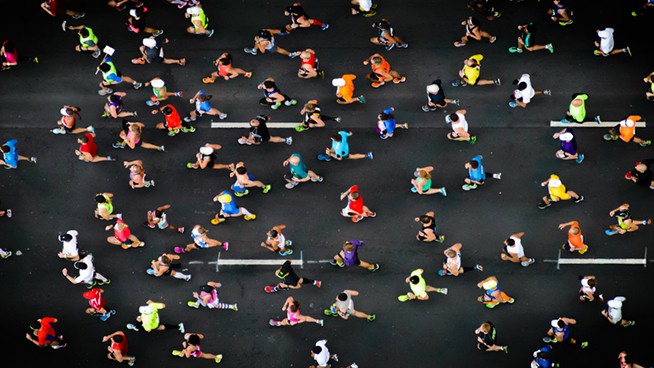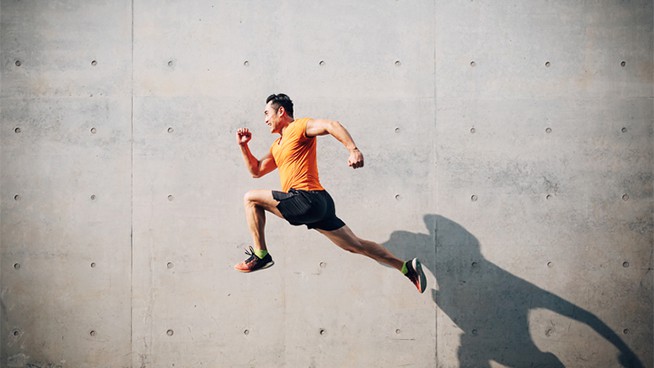Why Athletes Must Increase Absolute Speed
Simply defined, power is strength in hurry. When an athlete thinks of useful movements in their sport, power is often more important than just strength. Consider running, jumping, batting, throwing and kicking. The object (or body weight) is small, but is often very quickly in as little time as possible. This is also relevant to acceleration and sharp cutting (agility) movements. The training method is closely related to what is called absolute speed.
Absolute speed has little to do with speed in and of itself, and more to do with quick, functional sporting movements. Absolute speed is a portion (one quarter) of the static spring scale (also known as the absolute strength – absolute speed scale). A full diagram of the scale is below for reference. As a whole, the static spring scale is a continuous training model between strength (absolute strength) to power (absolute speed).
Absolute Strength <===> Strength Speed <===> Speed Strength <===> Absolute Speed
If we look at absolute speed and explosive speed training as a training method, it is defined by low load (i.e., little to no added weight) – high velocity (i.e., top speed); the exact opposite to absolute strength which is high load – low velocity. Typically, young athletes will spend most of their time training in this zone. Some common examples are trying to throw harder or faster, run quicker 40yd times, jumping higher, etc. Training resistance will consist of the regulation equipment (balls, bats, etc.) or the individuals body weight. Unlike strength (defined as the body creating internal stress to overcome an external force), absolute speed is concerned with creating more nerve pathways that pertain to a specific movement or activity. By creating these nerve pathways, the body will use more effectively and efficiently movements as second nature. Remember no weights should be used so that nerve pathways can develop and quicken without resistance.
Using sprinting as an example we will look at some training techniques associated with absolute speed. Focusing on lower limb mechanics, sprinting is triple movement(hip, knee, and ankle flexion) of the lead leg and triple movement (hip, knee, and ankle extension) of the back leg. The frontside movement mechanics involve the ankle, hamstrings (moving the knee) and the hip. As for the backside movement mechanics, they involve the ankle, quadriceps (moving the knee) and glutes (for hip movement). Simply put, sprinting is frontside and backside movement mechanics repeated quickly.
Strength-training exercises are integral in the development of absolute speed through targeting specific joint movements and muscles. This development helps as the majority of all sport specific movements require explosive force. Using the power training methods, the weight room is used to increase both strength and power(two components necessary to improve speed).
Before attempting these speed exercises an athlete should make sure they possess proper strength and flexibility for joint stability and range of motion.
Strength Prescription
– Squats (3 sets, 8-10 reps)(50%-55% 1RM)
– Box Depth Jumps(3 sets, 8-10 reps)
– Squat Jumps(3 sets, 8-10 reps)
– Jump Tucks (3 sets, 8-10 reps) (focus on the knees to chest movement to copy the hip, knee and ankle movement)
Note: Remember these are for absolute speed training, so each rep should be done explosively. After becoming comfortable with the movement speed, try to progress nonstop from 5, 10, 15, etc. Always keep in mind the formula as time is the biggest factor. Quicker is better. However, if you are unable to maintain good technique throughout the set, limit the reps or you will simply train bad technique and become injured.
Timed running exercises allow an athlete to practice moving and accelerating faster to condition the neuromuscular system. This is beneficial for speed training as it improves the firing patterns of fast twitch muscle fibers. Through assisted speed and resisted speed training an athlete can improve stride frequency(the speed at which you can move your legs during a run), speed-strength and stride length.
Speed Prescription (timed)
– Sprint Starts (5 yds timed)(2 sets, 3-5 sprints)(try to beat the previous timed rep)
– Timed Sprints
– 10 yds (1.5 – 2 sec) (2 sets, 3-5 sprints)
– 20 yds (1.0 – 2 sec) (2 sets, 3-5 sprints)
– 40 yds (1.0 – 2 sec) (2 sets, 3-5 sprints)
– Sand Sprints (2 sets, 3-5 sprints)
– 45yds Downhill Running(5-7 seconds) (2 sets, 3-5 sprints)
– Faster Treadmill Running (16-20 MPH @5-10 seconds initially, building up each week to 20-25 seconds)*Needs to be performed with experienced professional or serious injury will occur*
RECOMMENDED FOR YOU
MOST POPULAR
Why Athletes Must Increase Absolute Speed
Simply defined, power is strength in hurry. When an athlete thinks of useful movements in their sport, power is often more important than just strength. Consider running, jumping, batting, throwing and kicking. The object (or body weight) is small, but is often very quickly in as little time as possible. This is also relevant to acceleration and sharp cutting (agility) movements. The training method is closely related to what is called absolute speed.
Absolute speed has little to do with speed in and of itself, and more to do with quick, functional sporting movements. Absolute speed is a portion (one quarter) of the static spring scale (also known as the absolute strength – absolute speed scale). A full diagram of the scale is below for reference. As a whole, the static spring scale is a continuous training model between strength (absolute strength) to power (absolute speed).
Absolute Strength <===> Strength Speed <===> Speed Strength <===> Absolute Speed
If we look at absolute speed and explosive speed training as a training method, it is defined by low load (i.e., little to no added weight) – high velocity (i.e., top speed); the exact opposite to absolute strength which is high load – low velocity. Typically, young athletes will spend most of their time training in this zone. Some common examples are trying to throw harder or faster, run quicker 40yd times, jumping higher, etc. Training resistance will consist of the regulation equipment (balls, bats, etc.) or the individuals body weight. Unlike strength (defined as the body creating internal stress to overcome an external force), absolute speed is concerned with creating more nerve pathways that pertain to a specific movement or activity. By creating these nerve pathways, the body will use more effectively and efficiently movements as second nature. Remember no weights should be used so that nerve pathways can develop and quicken without resistance.
Using sprinting as an example we will look at some training techniques associated with absolute speed. Focusing on lower limb mechanics, sprinting is triple movement(hip, knee, and ankle flexion) of the lead leg and triple movement (hip, knee, and ankle extension) of the back leg. The frontside movement mechanics involve the ankle, hamstrings (moving the knee) and the hip. As for the backside movement mechanics, they involve the ankle, quadriceps (moving the knee) and glutes (for hip movement). Simply put, sprinting is frontside and backside movement mechanics repeated quickly.
Strength-training exercises are integral in the development of absolute speed through targeting specific joint movements and muscles. This development helps as the majority of all sport specific movements require explosive force. Using the power training methods, the weight room is used to increase both strength and power(two components necessary to improve speed).
Before attempting these speed exercises an athlete should make sure they possess proper strength and flexibility for joint stability and range of motion.
Strength Prescription
– Squats (3 sets, 8-10 reps)(50%-55% 1RM)
– Box Depth Jumps(3 sets, 8-10 reps)
– Squat Jumps(3 sets, 8-10 reps)
– Jump Tucks (3 sets, 8-10 reps) (focus on the knees to chest movement to copy the hip, knee and ankle movement)
Note: Remember these are for absolute speed training, so each rep should be done explosively. After becoming comfortable with the movement speed, try to progress nonstop from 5, 10, 15, etc. Always keep in mind the formula as time is the biggest factor. Quicker is better. However, if you are unable to maintain good technique throughout the set, limit the reps or you will simply train bad technique and become injured.
Timed running exercises allow an athlete to practice moving and accelerating faster to condition the neuromuscular system. This is beneficial for speed training as it improves the firing patterns of fast twitch muscle fibers. Through assisted speed and resisted speed training an athlete can improve stride frequency(the speed at which you can move your legs during a run), speed-strength and stride length.
Speed Prescription (timed)
– Sprint Starts (5 yds timed)(2 sets, 3-5 sprints)(try to beat the previous timed rep)
– Timed Sprints
– 10 yds (1.5 – 2 sec) (2 sets, 3-5 sprints)
– 20 yds (1.0 – 2 sec) (2 sets, 3-5 sprints)
– 40 yds (1.0 – 2 sec) (2 sets, 3-5 sprints)
– Sand Sprints (2 sets, 3-5 sprints)
– 45yds Downhill Running(5-7 seconds) (2 sets, 3-5 sprints)
– Faster Treadmill Running (16-20 MPH @5-10 seconds initially, building up each week to 20-25 seconds)*Needs to be performed with experienced professional or serious injury will occur*











